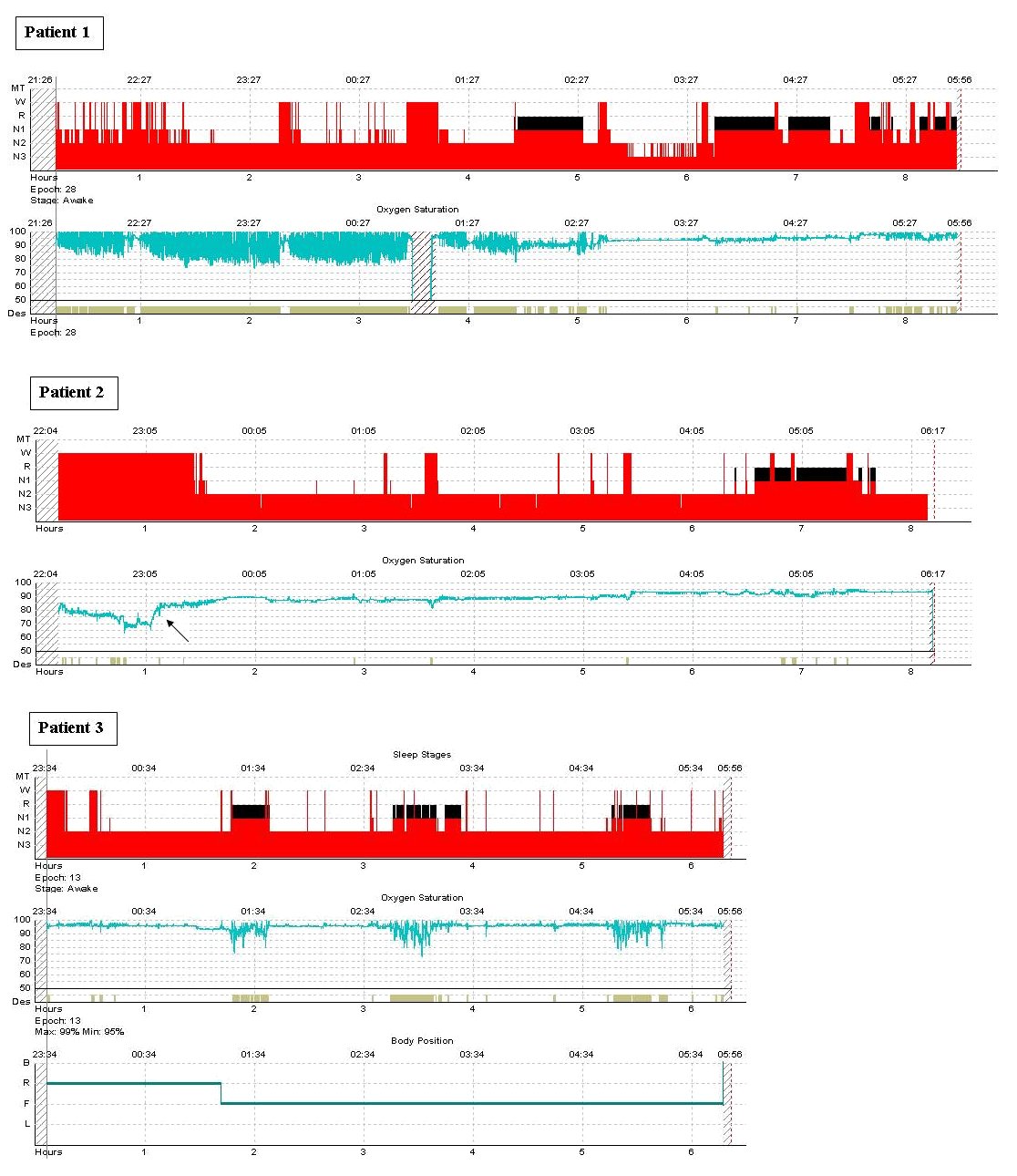Contributed by Amy S. Guralnick, M.D., Fellow in Sleep Medicine, Section of Pulmonary and Critical Care Medicine, University of Chicago and Babak Mokhlesi, M.D., M.Sc., Associate Professor of Medicine, Director, Sleep Disorders Center and Sleep Fellowship Program, University of Chicago
Three hypnograms each display the sleep stage and oxygen saturation of a polysomnogram from 3 separate patients.
- What is the underlying disorder(s) causing the abnormal oxygen saturation in each patient?
- What intervention(s) are indicated by the black arrow in patients 1 and 2?
Patient 1: Severe obstructive sleep apnea during a split night polysomnogram treated with CPAP.
Discussion: The oxygen saturation during the pre-treatment portion of the hypnogram is clearly abnormal with a classic “sawtooth” pattern. The administration of CPAP progressively improved the oxygen saturation as the pressure provided approached a therapeutic pressure. In addition, as the therapeutic CPAP level was achieved, the sleep fragmentation associated with OSA was effectively treated and a rebound in REM and slow wave sleep was observed. Beyond the optimal CPAP of 14 cm of water pressure, which effectively treated the obstructive respiratory events, the patient developed central apneas causing periodic oxyhemoglobin desaturations.
Lehman S, Antic NA, Thompson C, Catcheside PG, Mercer J, McEvoy RD. Central sleep apnea on commencement of continuous positive airway pressure in patients with a primary diagnosis of obstructive sleep apnea-hypopnea. J Clin Sleep Med.2007 Aug 15;3(5):462-6
Patient 2: Underlying severe chronic obstructive pulmonary disease treated with supplemental oxygen.
Discussion: The initial portion of the hypnogram is during wakefulness. During this period, the oxygen saturation is persistently low, without the typical “sawtooth” characteristic that is present during sleep-disordered breathing. The addition of supplemental oxygen increased the baseline oxygen saturation of the patient. This patient only had significant hypoxemia related to the underlying COPD. There was no evidence of sleep disordered breathing during the polysomnogram.
Patient 3: REM Related Obstructive Sleep Apnea
Discussion: Frequently, obstructive respiratory events can be seen predominantly in REM sleep, or become more severe in REM sleep. REM predominant sleep apnea has been described in women in particular. Patient 3 is a premenopausal woman with an overall AHI of 30/hr. The Non-REM AHI was 7/hr and the REM AHI was 82/hr. Thus, in non-REM sleep, the severity of sleep disordered breathing was mild, but in REM sleep it was very severe. The patient did not sleep supine the entire night, so positionality did not contribute to the sleep disordered breathing in this case.
Koo BB, Dostal J, Ioachimescu O, Budur K. The effects of gender and age on REM-related sleep-disordered breathing. Sleep Breath. 2008 Aug;12(3):259-64.
Peter V. Tishler, MD; Emma K. Larkin, MHS; Mark D. Schluchter, PhD; Susan Redline, MD, MPH Incidence of Sleep-Disordered Breathing in an Urban Adult Population The Relative Importance of Risk Factors in the Development of Sleep-Disordered Breathing JAMA. 2003;289:2230-2237.





